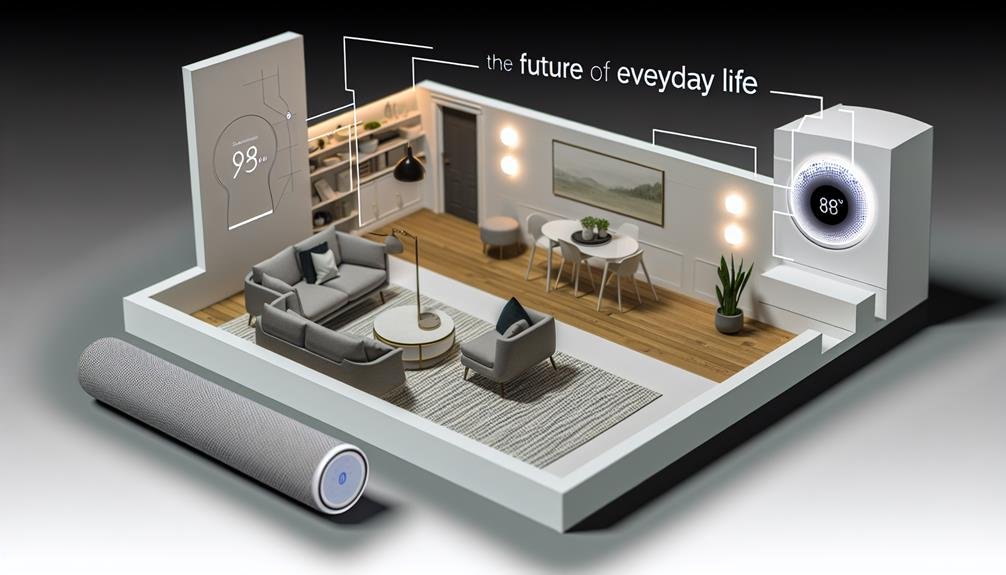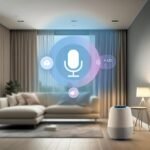Imagine your home as a ship sailing through the vast ocean of technology. As the winds of innovation continue to blow, it becomes crucial to equip your ship with the latest tools and techniques to navigate the ever-changing waters.
Smart home automation is the compass that guides you towards a future-proof home, making your life more convenient, secure, and efficient. But where do you start? How can you ensure that your home remains relevant and adaptable in the face of technological advancements?
In this discussion, we will explore the key strategies and insights that will help you future-proof your home with smart home automation, ensuring that you stay ahead of the curve and embrace the possibilities of tomorrow.
Key Takeaways
- Smart home automation integrates various devices and technologies, offering benefits such as remote control, energy savings, and enhanced security.
- When choosing smart home devices, consider your specific needs and preferences, and look for devices that offer integration and voice control.
- Smart home automation enhances security and safety by integrating security systems, cameras, sensors, and detectors.
- Smart home technology optimizes energy usage and reduces waste through features like remote climate control, real-time energy usage data, and motion sensors.
Understanding Smart Home Automation Basics
To understand the basics of smart home automation, you need to grasp the fundamental principles behind this innovative technology. Smart home automation refers to the integration of various smart devices and technologies within your home to create a more convenient, efficient, and secure living environment.
The benefits of home automation are numerous. Firstly, it allows you to control and monitor various aspects of your home remotely, providing you with a sense of freedom and flexibility. With a simple tap on your smartphone or voice command, you can control your lights, thermostat, security system, and even appliances from anywhere in the world.
Secondly, integrating smart home devices can lead to significant energy savings. By automating your lighting and heating systems, you can optimize their usage and reduce energy wastage. This not only helps the environment but also saves you money in the long run.
Lastly, smart home automation enhances the security and safety of your home. With features like smart locks, surveillance cameras, and motion sensors, you can remotely monitor and control access to your home, ensuring peace of mind even when you're away.
Choosing the Right Smart Home Devices
When choosing smart home devices, it is important to consider your specific needs and preferences in order to create a personalized and efficient smart home automation system. By selecting the right devices, you can enhance your home's capabilities and make your life easier and more convenient. One important aspect to consider is smart home integration, which allows different devices to work together seamlessly. This means that your smart lights can communicate with your smart thermostat, your security system can sync with your smart locks, and so on. Voice control is another key feature to look for in smart home devices. With voice control, you can simply speak commands to control your devices, eliminating the need for manual operation. This hands-free approach gives you the freedom to control your smart home with ease, whether you're cooking in the kitchen, relaxing in the living room, or even lying in bed. To help you make informed decisions, here is a table highlighting some popular smart home devices and their key features:
| Device | Key Features |
|---|---|
| Smart Thermostat | Temperature control, energy savings |
| Smart Lighting | Dimming, color changing, scheduling |
| Smart Lock | Keyless entry, remote access |
| Smart Security | Motion detection, video surveillance |
| Smart Speaker | Voice control, music streaming, smart hub |
Enhancing Security and Safety With Smart Home Automation
Enhance the security and safety of your home with the power of smart home automation. With smart home technology, you can integrate security systems, cameras, and sensors to create a comprehensive security network that keeps your home safe. By connecting these devices to a central hub, you can monitor and control them remotely, giving you peace of mind no matter where you are.
Smart home automation allows you to enhance security by setting up motion sensors that trigger lights or sirens when someone enters your property. This acts as a deterrent to potential intruders and alerts you to any suspicious activity. Additionally, you can integrate door and window sensors that send instant notifications to your smartphone when they're opened or tampered with, allowing you to take immediate action.
Furthermore, with the integration of smart home automation and entertainment systems, you can create the illusion of occupancy while you're away. By scheduling lights to turn on and off at specific times or controlling your TV and audio systems remotely, you can give the impression that your home is occupied, deterring potential burglars.
In terms of safety, smart home automation offers several features that can protect you and your loved ones. For instance, you can install smart smoke detectors that not only sound an alarm in case of a fire but also send alerts to your smartphone, allowing you to take action even if you're not at home. Similarly, you can integrate carbon monoxide detectors that monitor the air quality and promptly alert you to any dangerous levels.
Increasing Energy Efficiency With Smart Home Technology
By optimizing energy usage and reducing waste, smart home technology can significantly increase the energy efficiency of your household. Smart home automation systems offer various features that can help you manage and control your home's energy consumption more effectively.
One of the key ways smart home technology can enhance energy efficiency is by allowing you to monitor and adjust your home climate remotely. With the ability to control your thermostat from anywhere, you can ensure that your heating and cooling systems are only running when necessary. This not only helps reduce energy waste but also allows you to create a comfortable living environment without unnecessary energy consumption.
In addition to remote climate control, smart home automation systems can also provide you with real-time energy usage data. By monitoring your energy consumption patterns, you can identify areas where energy is being wasted and make adjustments accordingly. For example, you may discover that certain appliances or devices are consuming more energy than expected. With this information, you can take steps to reduce their usage or invest in more energy-efficient alternatives.
Furthermore, smart home technology can automatically adjust your home's energy usage based on factors such as occupancy and natural lighting. For instance, motion sensors can detect whether a room is occupied and adjust the lighting and temperature accordingly. This not only reduces energy waste but also ensures that your home remains comfortable and efficient without you having to constantly make manual adjustments.
Future-Proofing Your Home With Scalable Automation Solutions
To future-proof your home with scalable automation solutions, consider implementing a comprehensive smart home system that can adapt and expand with your evolving needs. By integrating smart home devices into your home automation system, you can create a seamless and interconnected environment that enhances your daily life.
Here are three key ways to future-proof your home with scalable automation solutions:
- Invest in a central control hub: A central control hub serves as the brain of your smart home system, allowing you to manage and control all your connected devices from a single interface. Look for a hub that supports a wide range of protocols and is compatible with popular smart home devices. This will ensure that you can easily add new devices to your system as they become available.
- Choose modular and expandable devices: Opt for smart devices that offer modular and expandable features. This allows you to start with basic functionality and add additional features or components as needed. For example, you can start with a basic security system and later expand it to include surveillance cameras, motion sensors, and smart locks.
- Consider cloud-based services: Cloud-based services offer scalability and flexibility, allowing you to access your smart home system remotely and easily add new features and functionalities. These services also provide automatic software updates, ensuring that your system stays up-to-date with the latest advancements in smart home technology.






